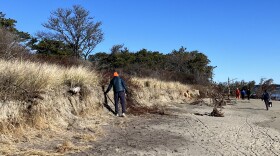Ryan Kapp spends his nights awake on the top of Mount Washington, watching the sky. On Sunday, he got a treat.
“It was a dull glow to begin with. And then it got brighter and wider. And then eventually around 10:00 on Sunday evening, we saw pillars and ribbons that were dancing across the sky,” he said.
Knapp, a senior staff meteorologist at the Mount Washington Observatory, says it’s uncommon to catch a glimpse of the Northern Lights from New Hampshire’s latitude.
“A lot of things have to come together for us to see them,” he said.
Despite the odds, Knapp has seen the Northern Lights two Sundays in a row.
Knapp says sightings may become more frequent in the coming months, as the sun approaches the middle of its 11-year cycle. The middle of the cycle is known as a “solar maximum,” when solar activity, like the kind that creates the conditions for the Northern Lights, peaks.
The National Oceanic and Atmospheric Administration forecast this October that the current solar cycle, which began in 2019, will peak between January and October of 2024, and it will be a stronger peak than they originally anticipated.
The Northern Lights start with a large expulsion of plasma and magnetic field from the sun’s corona, called a Coronal Mass Ejection.
“It basically spews a bunch of electrons into outer space,” Knapp said.
Those electrons interact with gasses in our atmosphere, he said, and that interaction creates the greens, purples, blues and reds in the lights.
“But the only reason why we've been having these back to back events, if you want to call them that, is just because the weather has aligned for us correctly,” Knapp said.
For the Northern Lights to be visible, it needs to be a clear night, with no fog, and few clouds. Too much moonlight can dull the colors, and make them harder to see.
Northern Lights enthusiasts can track solar weather through apps or online. Knapp says it’s also a good idea to familiarize yourself with the night sky before looking for the Northern Lights. And make sure to look North and not South, he said.
“A lot of people go out to look for the aurora for the first time and have no clue what the night sky normally looks like, so they might mix up seeing city lights glowing on the horizon as the Northern Lights, or they might be looking in the wrong direction,” he said.
The lights won’t be visible every night, and there will be long periods without any activity. But, Knapp says, there could be more chances to see them than in a normal year.





